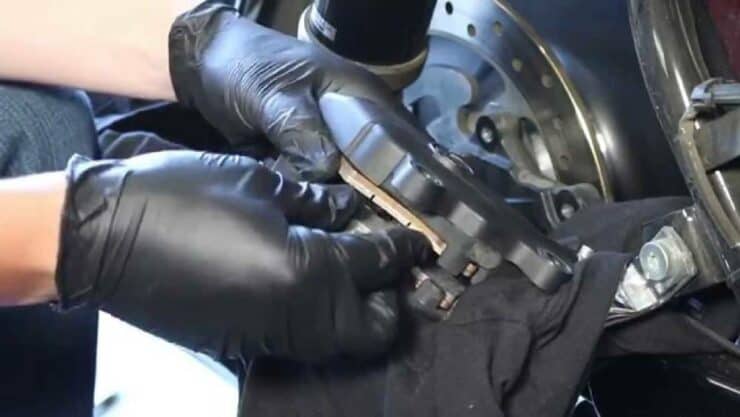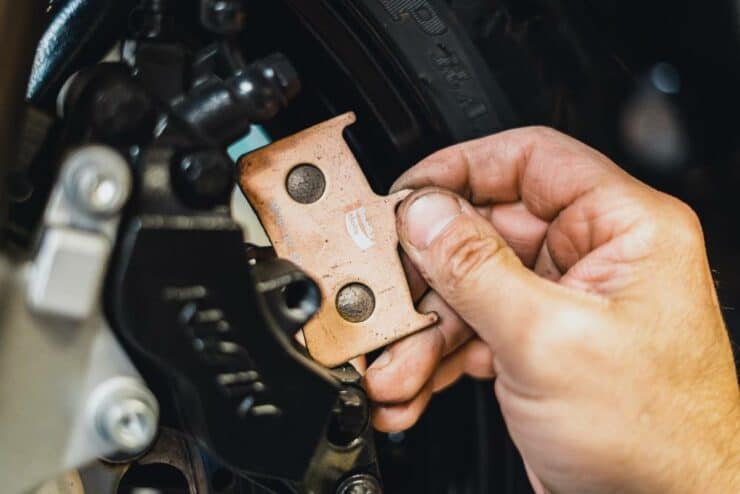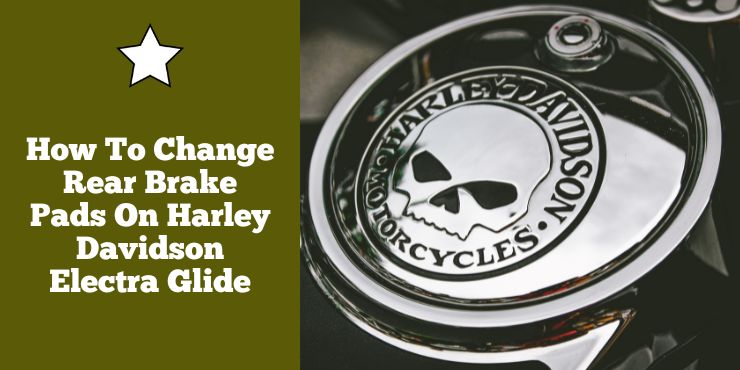Are you a proud owner of a Harley Davidson Electra Glide? If you are, then you know that, like any motorcycle, regular maintenance is key to keeping it in optimal condition. Changing the rear brake pads is an essential part of that maintenance schedule, and if you’ve never done it before, it can seem like a daunting task. Don’t worry – we’ve got you covered!
To change rear brake pads on an Electra Glide, lift the bike and remove the rear caliper bolts. Slide the caliper off, remove the old pads, insert new ones, and reinstall the caliper, tightening bolts to specification.
In this article, you’ll learn all the steps necessary to change the rear brake pads on your Harley Davidson Electra Glide. So read on and get ready to tackle this repair with confidence – you got this!
Overview of Rear Brake Pads on a Harley-Davidson Electra Glide
Rear brake pads are an integral part of your bike’s braking system, contributing to the effective declaration and overall stopping power. While the front brakes will typically provide the majority of stopping force, the rear brake will aid in stability, weight distribution, and controlling the bike during various conditions.
Different types of rear brake pads
A Harley-Davidson Electra Glide typically makes use of two types of rear brake pads – Organic and Sintered.
Organic pads are made using a blend of organic fibers and they’re known for their quiet operation and smooth initial bite. They offer a progressive and predictable braking feel, which makes them suitable for everyday riding and lighter loads. However, organic pads might wear out faster under more aggressive riding or heavy load conditions.
Sintered brake pads, on the other hand, consist of metallic particles fused together under high heat and pressure. These rear brake pads offer excellent durability, longer life, and consistent performance across a wide range of riding conditions. Sintered pads will provide improved braking power, which makes them well-suited for heavy loads, aggressive riding, and extended periods of braking.

Importance of rear brake pads
Understanding the importance of rear brake pads and maintaining them properly will be important for ensuring a safe and enjoyable riding experience on your Harley-Davidson Electra Glide. Here are the reasons rear brake pads are so important.
#1. Stopping power and control
The rear brake pads on your Harley-Davidson Electra Glide will contribute greatly to the overall stopping power and control of the motorcycle. While the front brakes offer the majority of the braking force, the rear brake assists in slowing down your bike, improving stability, and maintaining control.
#2. Weight distribution and stability
Proper weight distribution will be crucial for maintaining stability and control while riding your Electra Glide. The rear brake pads will help balance the weight transfer during deceleration, preventing the front suspension from diving excessively and ensuring optimal tire contact with the road surface. This balanced weight distribution will enhance stability, especially during cornering and maneuvering.
#3. Parking and low-speed control
The rear brake is especially important for parking and low-speed maneuvering. It will allow you to easily control the motorcycle at low speeds, providing precise modulation and preventing sudden stops or wheel lock-ups. The rear brake will be instrumental when maneuvering in tight spaces, performing U-turns, or navigating through congested traffic.
#4. Emergency situations
During emergency situations where sudden braking is needed, having properly functioning rear brake pads can make a huge difference. The rear brake will provide an additional braking force that can help reduce stopping distances while helping you avoid potential hazards. It can act as an important backup, complementing the front brakes to ensure maximum stopping power when needed most.
Signs that the rear brake pads on your Electra Glide need changing
The rear brake pads on your Harley-Davidson Electra Glide play a key role in ensuring safe and effective braking performance. Over time, these brake pads wear down and have to be replaced to maintain optimal stopping power. It is important to recognize the signs indicating that your rear brake pads require replacement. By paying attention to these signs, you’ll be able to ensure that your bike’s braking system remains in top condition.
#1. Decreased pad thickness
One of the most significant signs that your rear brake pads need changing is when their thickness becomes noticeably reduced. You should inspect the pads visually through the inspection window or by removing the caliper to check their thickness. If the brake pad material is worn close to or beyond the recommended minimum thickness indicated by the manufacturer, it’ll be time for a replacement.
#2. Squealing or squeaking sounds
If you hear a high-pitched squealing or squeaking sound when you’re applying the rear brake, it might indicate worn brake pads. Most brake pads come equipped with wear indicators, small metal tabs that contact the rotor surface when the pads reach a certain level of wear. These indicators produce a distinct noise to alert you that the brake pads need attention.
#3. Grinding or metal-on-metal noise
A grinding or metal-on-metal noise while braking will be a significant indication that the rear brake pads are worn beyond their limits. When the brake pad material is fully depleted, the metal backing plate of the pads will come in contact with the rotor, resulting in a harsh grinding sound. Continuing to ride in this condition could result in significant damage to the brake rotor, leading to costly repairs.
#4. Reduced braking performance
If you notice a decrease in braking performance or longer stopping distances, it might be a sign of worn rear brake pads. As the pads wear down, their ability to grip the rotor and offer adequate friction will diminish. This can lead to a spongy brake pedal, delayed response, or a decrease in stopping power. If you feel any abnormalities in your bike’s braking performance, you must inspect the rear brake pads.
#5. Visual inspection
You must perform a visual inspection of the rear brake pads through the inspection window or by simply removing the caliper. Look for any signs of excessive wear, such as uneven pad wear, cracking, or glazing on the pad surface. Moreover, check for any oil or fluid contamination on the pads, which can adversely affect their performance.
#6. Dashboard warning light
Some Harley-Davidson Electra Glide models come equipped with a brake warning light on the dashboard. If this light illuminates, then it indicates a potential issue with the rear brake system, including worn brake pads. If the warning light activates, it’ll be important that you address the issue promptly by inspecting and replacing the rear brake pads.

Preparation for changing rear brake pads
Changing the rear brake pads on your Harley-Davidson Electra Glide will be an essential maintenance task. However, before you can dive deep into the rear brake pad replacement process, carrying out proper preparation will be important. Preparing everything properly sets up the foundation for a successful rear brake pad replacement.
#1. Gather tools and supplies
Before you start replacing the rear brake pads on your Harley-Davidson Electra Glide, you will need to gather a few tools and supplies. Some of them include –
- Socket and wrench set – A comprehensive set of sockets and wrenches will be required for removing the brake caliper and various mounting bolts
- Allen wrench set – Many components on the Harley-Davidson Electra Glide use Allen head bolts, so having a set of Allen wrenches in different sizes will be essential
- Torque wrench – A torque wrench will be important for accurately tightening bolts according to the manufacturer’s specifications
- C-clamp or Brake piston compression tool – A C-clamp or brake piston compression tool will be needed for retracting the brake pistons and allowing space for the new brake pads
- Brake cleaner – A brake cleaner will help remove dirt, oil, and brake dust from the brake caliper and rotor, ensuring proper rad-to-rotor contact
- Brake lubricant – You’ll have to apply brake lubricant to the caliper slide pins and other appropriate areas to prevent binding and ensure smooth operation
- Brake pads – Acquire high-quality rear brake pads specifically designed for your bike as you’ll be able to choose between original equipment manufacturer pads or aftermarket options
- Safety equipment – You shouldn’t forget safety equipment such as gloves and safety glasses to protect yourself during the maintenance process
#2. Raise and secure the bike
For ensuring a safe working environment and proper access to the rear brake caliper, you will need to raise and secure your Electra Glide. To do that, you need to –
- Find a surface level – First, you should choose a flat and stable surface for parking your Electra Glide
- Secure the front wheel – Use a wheel chock or have someone hold the front wheel steady to prevent the bike from rolling forward or backward during the maintenance process
- Use a motorcycle lift – If available, using a motorcycle lift or stand can simplify the process by giving a stable platform and easy access to the rear wheel and brake caliper
- Lift the rear of the bike – If a motorcycle lift isn’t available, make use of a sturdy rear stand or have a helper assist in lifting the rear of the bike and give it enough clearance to remove the rear wheel and access the brake caliper
#3. Secure the bike
Once your motorcycle is raised, ensure that it is properly secured to prevent any accidental movement. Secure your raised bike to a stable object like a sturdy post or heavy-duty rack using straps or ratchet tie-downs. Attach them to the frame or designated attachment points for preventing the bike from tipping or falling.
If you are using a rear stand, you must ensure it is securely in place. Additionally, you should consider placing blocks behind the front and/or rear wheels to provide extra stability and prevent any accidental movement.
How to change rear brake pads on Harley-Davidson Electra Glide
Maintaining the brake system on your Electra Glide will be important for optimal performance and rider safety. Changing the rear brake pads will be a key part of this maintenance routine. This step-by-step guide will walk you through the process of removing the rear brake pads and installing new ones. Here are the steps that you will need to follow –
Step 1: Remove the rear wheel
Start off by loosening the axle nut with the appropriate socket and wrench. Once loosened, you should remove the axle nut and slide out the axle. Gently pull the rear wheel out from the swingarm and then set it aside in a safe location.
Step 2: Remove the old brake pads
Locate the brake caliper on the inside of the rear wheel. Then, remove the retaining bolts or pins that secure the brake pads in place. You must carefully remove the old brake pads from the caliper. Take note of the orientation to ensure proper installation of the new brake pads.
Step 3: Inspect and clean the brake system
Once the old brake pads have been removed, you should take this opportunity to inspect the brake caliper, rotor, and other components for any signs of damage, excessive wear, or fluid leakage. Use brake cleaner to thoroughly clean the caliper, pistons, and rotor surfaces. Inspect the brake caliper pins and ensure that they’re moving freely. Apply brake lubricant to the caliper slide pines and other appropriate areas for smooth operation.
Step 4: Install the new rear brake pads
Take the new brake pads and insert them into the brake caliper, aligning them with the caliper housing. Make sure that the pads fit snugly and align correctly with the brake rotor. If the brake pads have retaining clips or pins, you should secure them in place following the manufacturer’s instructions.
Step 5: Install the rear brake caliper
You should carefully position the rear brake caliper over the brake pads, ensuring that the brake pads are properly aligned with the rotor. Insert the mounting bolts or pins through the caliper and into the mounting holes on the swingarm. Tighten the bolts or pins to the manufacturer’s recommended torque specifications using a torque wrench.
Step 6: Verify proper brake pad placement
Before you lower your bike, you must double-check that the brake pads are positioned correctly and aligned with the rotor. Make sure that they sit evenly on both sides of the rotor and aren’t misaligned or touching any other components. You must verify that the brake caliper is centered around the rotor and moves freely.

Finishing up after installing brake pads on Electra Glide
Once you have successfully installed new rear brake pads on your Harley-Davidson Electra Glide, it’ll be important that you complete the final steps to ensure proper reassembly and functionality of your bike’s braking system. Here are the steps that you will need to follow to finalize the installation. These steps will allow you to conclude the rear brake pad change on your Electra Glide.
Step 1: Reinstall the wheels
Take the rear wheel and align it with the swingarm and brake caliper. You should carefully slide the axle through the wheel’s axle slots, ensuring it fits snugly. Then, insert the axle nut and tighten it to the manufacturer’s recommended torque using a torque wrench. You must confirm that the wheel spins freely without any obstruction.
Step 2: Lower the bike
If you’re using a motorcycle lift or rear stand for elevating your Electra Glide, you will need to carefully lower the bike to the ground. You should ensure that the motorcycle is stable and secure, ensuring that it rests evenly on both wheels. You must exercise caution during the lowering process to avoid sudden movements or accidents.
Step 3: Test the brakes
Once your bike is lowered, it will be important that you conduct a comprehensive brake test to verify proper functionality. Begin by starting your Harley-Davidson Electra Glide’s engine and let it idle for a while.
Then, you should squeeze the rear brake lever or press the rear brake pedal for engaging the brake system. Observe the resistance and responsiveness of the rear brake. The lever or pedal needs to feel firm, with a smooth engagement and gradual increase in braking power.
With your Electra Glide in a safe and open area, you should slowly ride your bike at a low speed. Gradually apply the rear brake for testing its effectiveness and responsiveness. Make sure that your bike comes to a smooth and controlled stop without any abnormal noises or vibrations.
In a controlled environment, you should perform an emergency stop to assess the rear brake’s ability to provide quick and effective stopping power. Ensure that the rear brake engages promptly, allowing you to come to a complete halt in a relatively short distance.
Throughout the test, you should pay close attention to the overall braking performance, including the consistency of brake engagement, the absence of any unusual noises, or vibrations, and the effectiveness of the rear brake in various riding conditions.
Clean and dispose of used rear brake pads
When replacing rear brake pads on your Harley-Davidson Electra Glide, it is important that you don’t just focus on the installation of new brake pads but also on the proper cleaning and disposal of the old ones. After changing the rear brake pads on your Street Glide, you must clean up and dispose of used brake pads in an environmentally friendly manner, ensuring the safe handling and disposal of these components.
Before handling the used brake pads, you must ensure that you have the necessary safety equipment, including gloves and eye protection. Brake pads could contain harmful substances such as asbestos or heavy metal, so taking proper precautions will be important.
Cleaning the brake pads
Once you have finished changing the rear brake pads, you won’t just have to clean the work area but you will also need to clean the old brake pads. It’ll be even more important if you’re looking to recycle or dispose of these components. For cleaning the used brake pads, you will need to follow these steps –
You must set up a clean and well-ventilated workspace for avoiding contamination or inhaling dust particles. Lay down a protective mat or newspaper for catching any debris. Make use of a stiff brush or compressed air to remove loose dirt, dust, and debris from the surface of the brake pads. Be cautious so that you don’t end up inhaling the dust particles while cleaning.
Spray brake cleaner onto the brake pads to remove residual brake fluid, oil, or contaminants. Make sure that you apply the cleaner in a well-ventilated area. Remember to follow the instructions provided by the manufacturer. Allow the brake cleaner to evaporate completely before proceeding.
You must also examine the used brake pads for any signs of excessive wear, cracking, or damage. If the pads are severely worn or damaged, they might have to be disposed of immediately. You’ll need to consult with a professional or local regulations for determining the appropriate course of action.
Proper disposal of used rear brake pads
Once you have cleaned the used brake pads, it’ll be important to dispose of them properly to minimize environmental impact. But before you can do that, you must check your local regulations or contact a recycling center for determining the specific guidelines for disposing of used rear brake pads in your area. Some locations might have specific collection points or recycling programs for rear brake pads.
You should look for recycling facilities that accept automotive parts such as brake pads. These facilities might have processes in place to safely handle and dispose of brake pads. If you’re uncertain about how to dispose of the used brake pads or if they contain hazardous materials, you must consult with a professional waste management company. They will guide you and assist you with handling and disposing of these components.
If you have to store used brake pads temporarily, you can place them in a sealed bag or a container. This will prevent any contamination or release of hazardous materials. You must also label the container as “used rear brake pads” to ensure proper handling.
Also read: What is the Loudest Harley-Davidson?
FAQs
What tools are needed to change the rear brake pads on a Harley Davidson Electra Glide?
To change the rear brake pads on a Harley Davidson Electra Glide, you will need a few tools including a ratchet, a 10mm socket, a flathead screwdriver, and a pair of pliers.
How do I know when the rear brake pads need to be changed?
The rear brake pads on a Harley Davidson Electra Glide should be changed when they become worn and start to make a squealing noise when the brakes are applied. You can also visually inspect the brake pads to see if they need to be replaced.
What is the process for changing the rear brake pads?
The process for changing the rear brake pads on a Harley Davidson Electra Glide includes removing the wheel, disconnecting the brake cable, removing the caliper and old brake pads, installing the new brake pads, and reinstalling the caliper and wheel. It’s important to make sure the brake pads are properly aligned before reinstalling the wheel.

